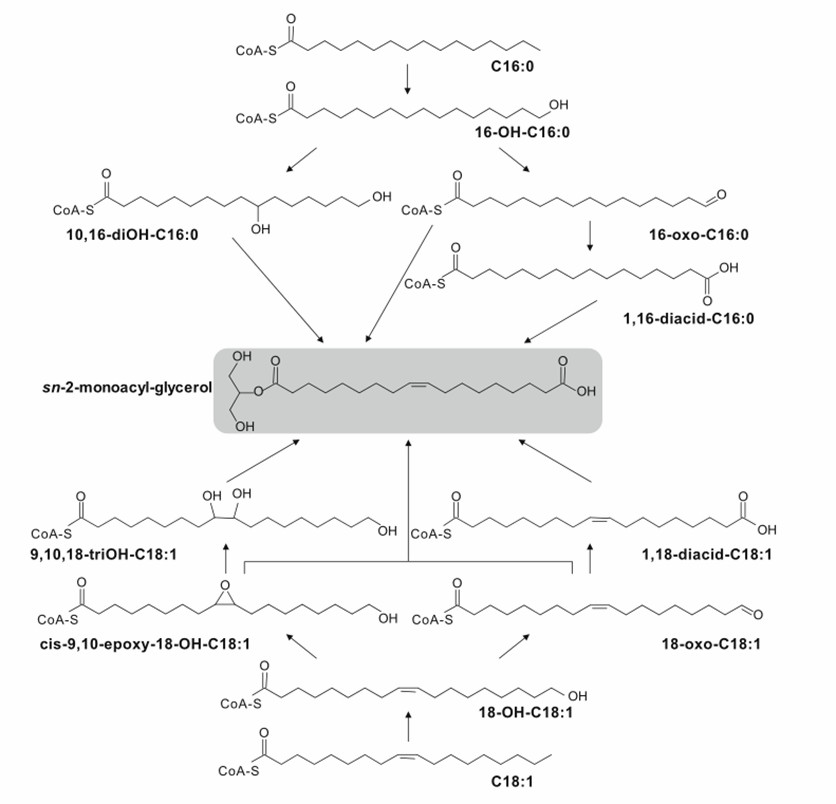Lifeasible contributes to studying the plant cuticle in plant-pathogen interactions and offers services to help study the role of cutin in plant-pathogen interactions.
The cuticle is of evolutionary importance in colonizing terrestrial plants, where it acts as a physical barrier, mediating plant resistance to pathogens, pests, and adverse environments. Cutin makes up approximately 80% of the plant cuticle and is an insoluble and fatty acid-derived aliphatic biomacromolecule. The synthesis of cutin monomer (Fig. 1), the polymerization of cutin, and the degradation of cutin influence plant-pathogen interactions. For example, the cuticle monomers released by cutinase work as a signal to induce pathogenic cutinase activity, which results in deeper penetration and infection in plants. Understanding changes in cutin's synthesis, structure, and composition in plant-pathogen interactions can help develop pathogen-resistant plants. Lifeasible offers professional services to help study these changes of cutin for plant protection research.
 Fig. 1 Cutin monomer biosynthetic pathways (Joubès and Domergue, 2020).
Fig. 1 Cutin monomer biosynthetic pathways (Joubès and Domergue, 2020).
Analysis of cutin
We help analyze the amount, composition, and structure of plant cutin.
We help to remove interference from cell wall components and cuticular waxes to aid cutin isolation. We help to depolymerize cutin sufficiently to obtain cutin monomers. We usually use 3 N methanolic hydrochloride (Me-OH-HCl) for depolymerization. We then use the gas chromatography-mass spectrometry (GC-MS) instrument to help analyze the type and content of cutin monomers.
We help detect the structure of plant cutin. We can use high-resolution magic angle spinning (HR-MAS) nuclear magnetic resonance (NMR) spectroscopy to help detect the crosslinking of cutin. We can use transmission electron microscopy (TEM) to help detect detailed structural features of cutin, such as amorphous, lamellate, and reticulate.
Testing the effect of different cutin on plant resistance
We help analyze the resistance of different amounts, compositions, or structures of cutin against pathogens. For plants with different cutin, we help infect them using the same pathogen. We then help to analyze pathogen invasion, including the area infected by the pathogen, the rate of invasion, and the expression of enzymes associated with pathogen invasion (especially cutinases). We also help to analyze plant resistance, including the plant's PTI and ETI response. Furthermore, we can also help detect the expression of cutin-associated genes to help analyze plant-pathogen interactions.
Characterization of synthetic, polymerization, and translocation genes for cutin
We help analyze the effects of different genetic mutations in plants on plant cutin. We help construct mutant plants and detect alterations in cutin. We also help further explore the specific role of mutant genes on cutin, including regulation of the production, polymerization, and translocation of cutin monomers. For example, when studying the effect of mutant genes on the cutin transport profile, we can measure the expression of heme-transport proteins ABCG11 and ABCG13 and the complete transport protein ABCG32 to determine the specific effects.
Lifeasible helps to study the role of plant cutin in plant-pathogen interactions. We help to analyze plant cutin, characterize cutin-related genes, and explore the effects of different cutin on plant resistance. If you need these services, please do not hesitate to contact us.
References
Lifeasible has established a one-stop service platform for plants. In addition to obtaining customized solutions for plant genetic engineering, customers can also conduct follow-up analysis and research on plants through our analysis platform. The analytical services we provide include but are not limited to the following:
Get Latest Lifeasible News and Updates Directly to Your Inbox
Adaptive Evolutionary Mechanism of Plants
February 28, 2025
Unraveling Cotton Development: Insights from Multi-Omics Studies
February 27, 2025